
Prof. Dr. Hedef Dhafir El-Yassin
2013
1
INTRODUCTION
TO THE
BIOCHEMISTRY
OF HORMONES
AND THEIR
RECPTORS
2013
Prof. Dr. Hedef Dhafir El-Yassin

Prof. Dr. Hedef Dhafir El-Yassin
2013
2
Introduction to the Biochemistry of Hormones and their
Receptors
Lectuctre1
Sunday 17/2/2013
Objectives:
1. To understand the biochemical nature and diversity of hormones and
their classifications.
2. To understand the role and nature of receptors on target cells
3. To understand the mechanism of regulation of hormones
The endocrine system is one of the two coordinating and integrating systems
of the body. It acts through chemical messengers - hormones
–carried in the
circulation.
Two systems control all physiologic processes:
The nervous system
exerts point-to-point control through nerves, similar
to sending messages by conventional telephone. Nervous control is
electrical in nature and fast.
The endocrine system
broadcasts its hormonal messages to essentially
all cells by secretion into blood and extracellular fluid. Like a radio
broadcast, it requires a receiver to get the message - in the case of
endocrine messages, cells must bear a receptor for the hormone being
broadcast in order to respond.
Endocrinology is the study of hormones, their receptors and the intracellular
signaling pathways they invoke. Distinct endocrine organs are scattered
throughout the body. These are organs that are largely or at least famously
devoted to secretion of hormones. In addition to the classical endocrine
organs, many other cells in the body secrete hormones. Myocytes in the atria
of the heart and scattered epithelial cells in the stomach and small intestine
are examples of what is sometimes called the "diffuse" endocrine system. If

Prof. Dr. Hedef Dhafir El-Yassin
2013
3
the term hormone is defined broadly to include all secreted chemical
messengers, then virtually all cells can be considered part of the endocrine
system.
All pathophysiologic events are influenced by the endocrine milieu:
There are no cell types, organs or processes that are not influenced -
often profoundly - by hormone signaling.
All "large" physiologic effects are mediated by multiple hormones acting
in concert: Normal growth from birth to adulthood, for example, is surely
dependent on growth hormone, but thyroid hormones, insulin-like
growth factor-1, glucocorticoids and several other hormones are also
critically involved in this process.
There are many hormones known and little doubt that others remain to
be discovered.
Quick quiz 1:
The purpose of the endocrine system is to:
1. deliver nutrients to the boy's cells
2. regulate and integrate the body's metabolic activities
3. eliminate waste products from the body
4. control the body's temperature and produce cells.

Prof. Dr. Hedef Dhafir El-Yassin
2013
4
Hormones, Receptors and Target Cells
1. Classes of Hormones
Knowing the basic structure of a hormone gives a considerable knowledge
about its receptor and mechanism of action.
Like all molecules, hormones are synthesized, exist in a biologically active
state for a time, and then degrade or are destroyed. Having an appreciation
for the "half-life" and mode of elimination of a hormone aids in understanding
its role in physiology and is critical when using hormones as drugs.
Most commonly, hormones are categorized into four structural groups,
with members of each group having many properties in common:
Fatty acid derivatives - Eicosanoids
1.
Peptides and Proteins
Peptide and protein hormones are products of translation. They vary
considerably in size and post-translational modifications, ranging from
peptides as short as three amino acids to large, multisubunit glycoproteins.
Peptide hormones are synthesized in endoplasmic reticulum, transferred to
the Golgi and packaged into secretory vesicles for export.
They can be secreted by one of two pathways:
Regulated secretion: The cell stores hormone in secretory granules
and releases them in "bursts" when stimulated. This is the most
commonly used pathway and allows cells to secrete a large amount of
hormone over a short period of time.
Constitutive secretion: The cell does not store hormone, but secretes
it from secretory vesicles as it is synthesized.

Prof. Dr. Hedef Dhafir El-Yassin
2013
5
Most peptide hormones circulate unbound to other proteins, but exceptions
exist; for example, insulin-like growth factor-1 binds to one of several binding
proteins. In general, the half-life of circulating peptide hormones is only a few
minutes.
Several important peptide hormones are secreted from the pituitary gland.
The anterior pituitary secretes:
Luteinizing hormone and follicle stimulating hormone, which act on the
gonads.
prolactin, which acts on the mammary gland,
adrenocortiotrpic hormone (ACTH), which acts on the adrenal cortex to
regulate the secretion of glucocorticoids, and
growth hormone, which acts on bone, muscle and liver.
The posterior pituitary gland secretes:
antidiuretic hormone, also called vasopressin, and
oxytocin.
Peptide hormones are produced by many different organs and tissues,
however, including:
the heart (atrial-natriuretic peptide (ANP) or atrial natriuretic factor
(ANF))
pancreas (insulin and somatostatin),
the gastrointestinal tract cholecystokinin, gastrin, and
fat stores (leptin)
Many neurotransmitters are secreted and released in a similar fashion to
peptide hormones, and some 'neuropeptides' may be used as
neurotransmitters in the nervous system in addition to acting as hormones
when released into the blood. When a peptide hormone binds to receptors on
the surface of the cell, a second messenger appears in the cytoplasm.
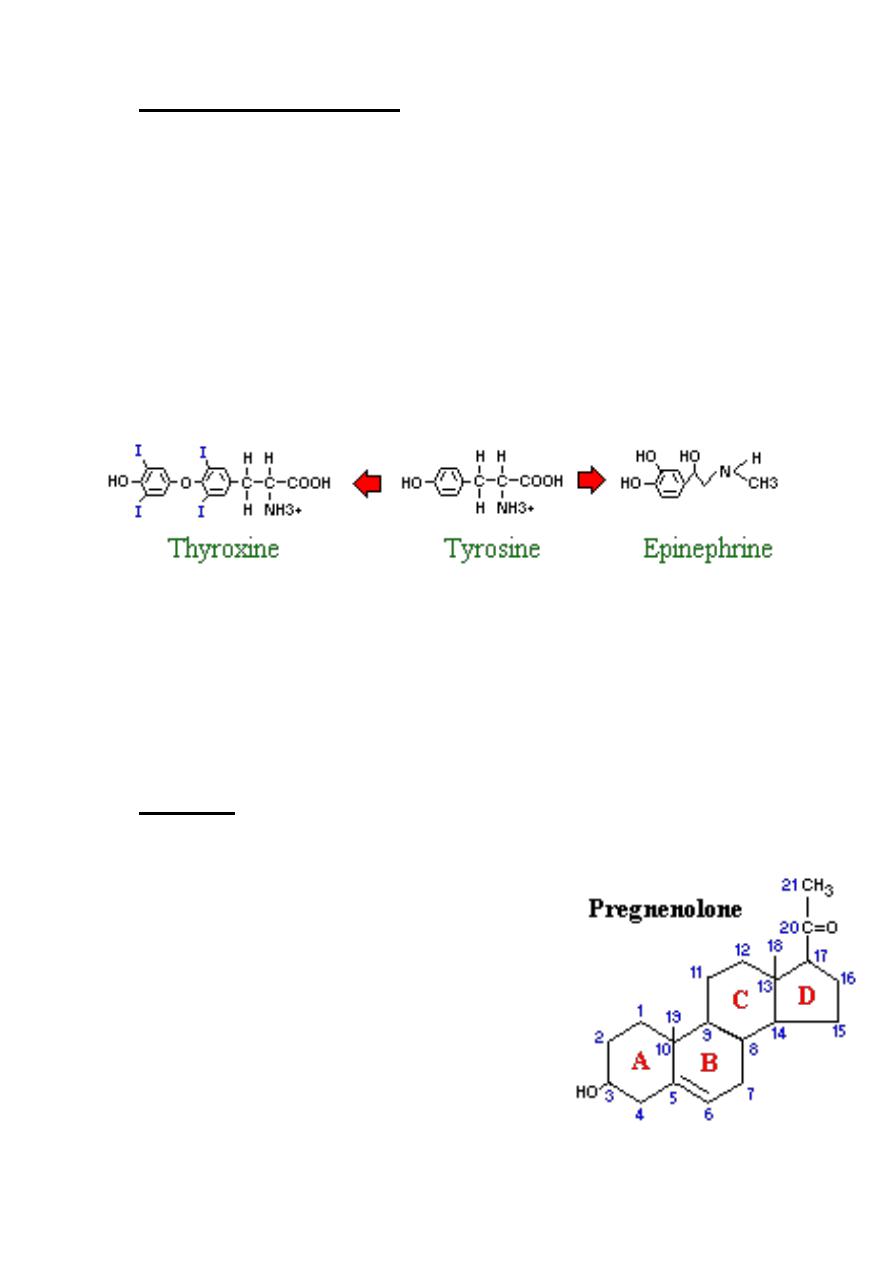
Prof. Dr. Hedef Dhafir El-Yassin
2013
6
2.
Amino acid derivatives
There are two groups of hormones derived from the amino acid
tyrosine:
Thyroid hormones are basically a "double" tyrosine with the critical
incorporation of 3 or 4 iodine atoms.
Catecholamines include epinephrine and norepinephrine, which are
used as both hormones and neurotransmitters.
The circulating half-life of thyroid hormones is on the order of a few days.
Two other amino acids are used for synthesis of hormones:
Tryptophan is the precursor to serotonin and the pineal hormone
melatonin
Glutamic acid is converted to histamine
3.
Steroids
Steroids are lipids and, more specifically, derivatives of cholesterol.
Examples include the sex steroids such as
testosterone and adrenal steroids such as cortisol.
The first and rate-limiting step in the synthesis of
all steroid hormones is conversion of cholesterol to
pregnenolone, which demonstrate the system of
numbering rings and carbons for identification of
different steroid hormones.
Pregnenolone is formed on the inner membrane of
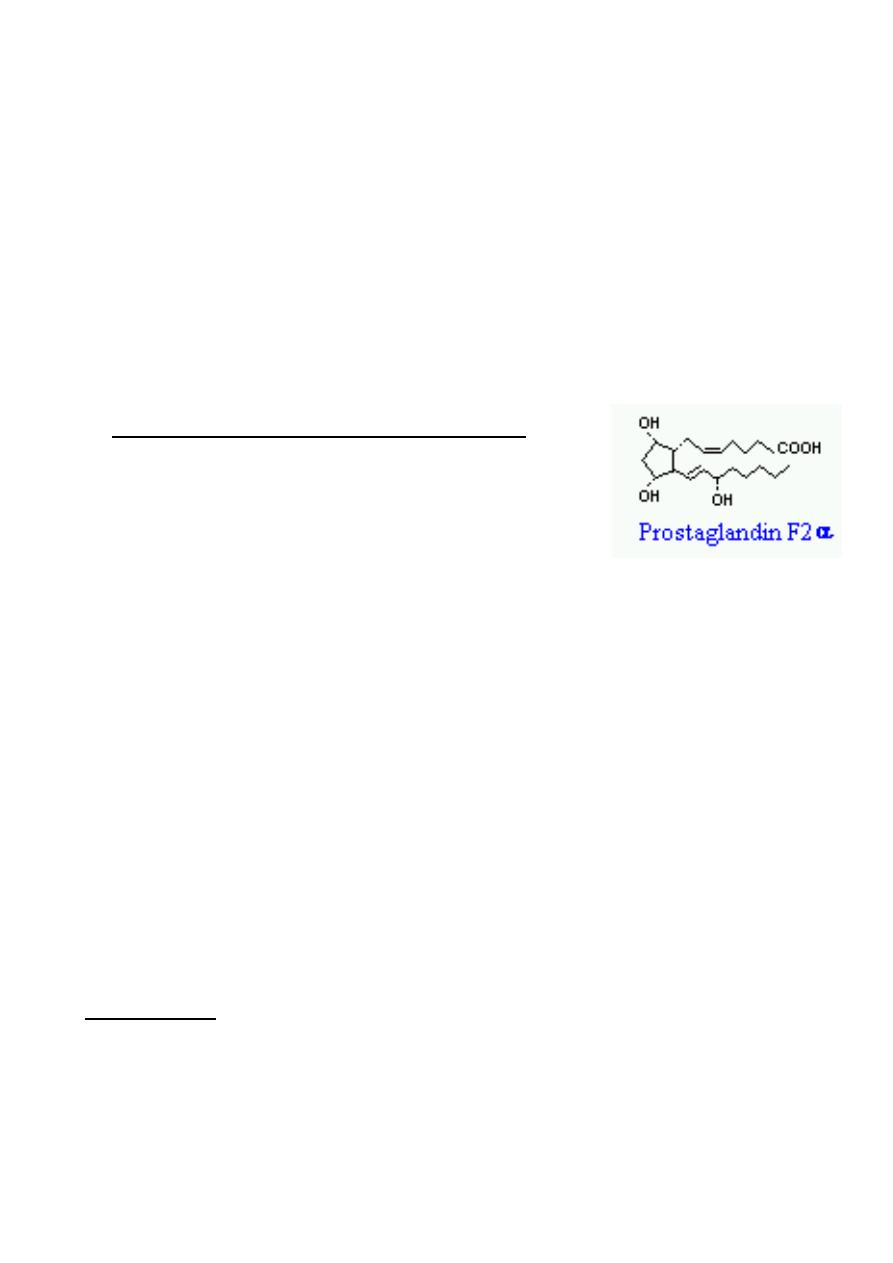
Prof. Dr. Hedef Dhafir El-Yassin
2013
7
mitochondria then shuttled back and forth between mitochondrion and the
endoplasmic reticulum for further enzymatic transformations involved in
synthesis of derivative steroid hormones.
Newly synthesized steroid hormones are rapidly secreted from the cell, with
little if any storage. Increases in secretion reflect accelerated rates of
synthesis. Following secretion, all steroids bind to some extent to plasma
proteins.
Steroid hormones are typically eliminated by inactivating metabolic
transformations and excretion in urine or bile.
4. Fatty Acid Derivatives - Eicosanoids
Eicosanoids are a large group of molecules derived from
polyunsaturated fatty acids. The principal groups of
hormones of this class are prostaglandins, prostacyclins,
leukotrienes and thromboxanes.
Arachadonic acid is the most abundant precursor for these hormones. Stores
of arachadonic acid are present in membrane lipids and released through the
action of various lipases.
A great variety of cells produce prostaglandins , including those of the liver,
kidneys, heart, lungs, thymus gland, pancreas, brain, and reproductive
organs. In contrast to hormones, prostaglandins usually act locally, affecting
only adjacent cells or the very cell that secreted it.
Prostaglandins are potent and are presented in very small quantities. They
are not stored in cells but rather are synthesized just before release. These
hormones are rapidly inactivated by being metabolized, and are typically
active for only a few seconds
Quick quiz 2:
How are prostaglandins different from hormones?
A
They do not use the blood for transportation, they act locally and are
synthesized in cell membrane just before release.
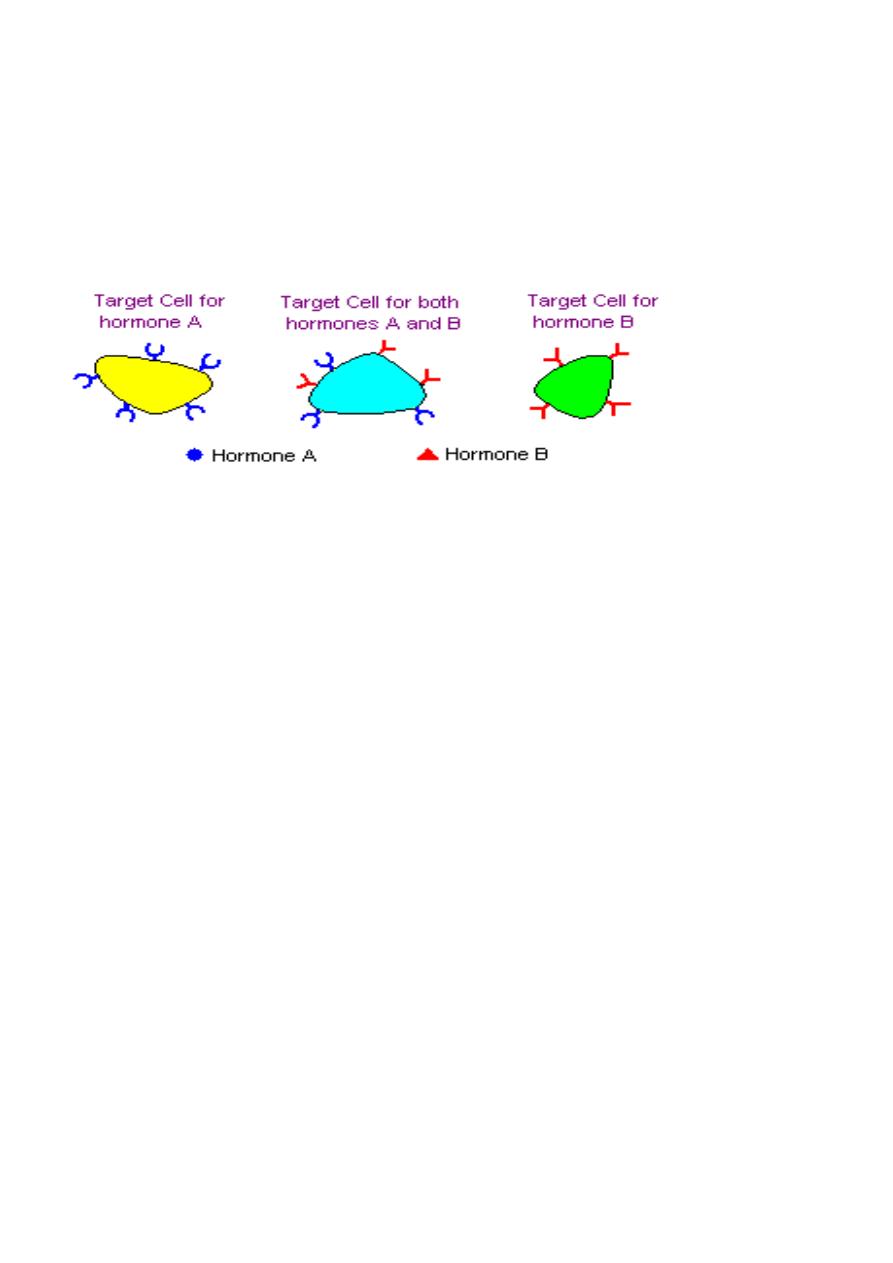
Prof. Dr. Hedef Dhafir El-Yassin
2013
8
2.
Receptors and Target Cells
A given hormone usually affects only a limited number of cells, which
are called target cells. A target cell responds to a hormone because it
bears receptors for the hormone.
Hormone
receptors
are found
either exposed on the surface of the cell or within the cell, depending on the
type of hormone. In very basic terms, binding of hormone to receptor triggers
a cascade of reactions within the cell that affects function.
Hormone receptors have two essential qualities:
1. The receptor must be able to recognize a unique binding site within the
hormone in order to discriminate between the hormone and all other
proteins.
2. The receptor must be able to transmit the information gained from
binding to the hormone into a cellular response.
Hormones may be secreted into blood and affect cells at distant sites. Some
hormones known to act and affect neighboring cells or even have effects on
the same cells that secreted the hormone. . Three actions are defined:
Endocrine action
: the hormone is distributed in blood and binds to distant
target cells.
Paracrine action
: the hormone acts locally by diffusing from its source to
target cells in the neighborhood.
Autocrine action
: the hormone acts on the same cell that produced it.
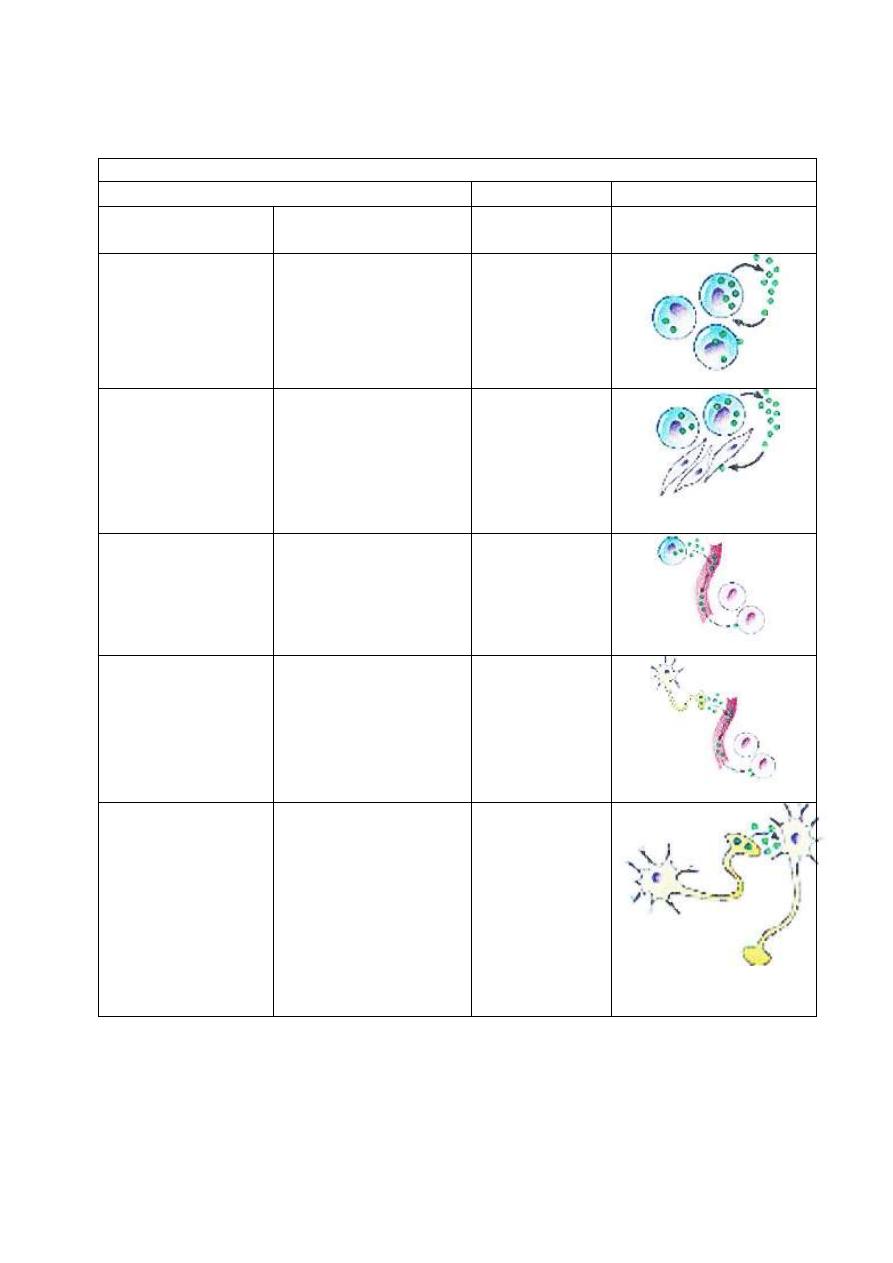
Prof. Dr. Hedef Dhafir El-Yassin
2013
9
Types of hormones
Chemical messengers
Example
Description
Intracellular
chemical signal
Prostaglandins
Secreted by cells in a
local area and
influences the activity
of the same cell from
which it was secreted
Autocrine
Histamine,
Prostaglandins
Produced by a wide
variety of tissues and
secreted into tissue
spaces; has a
localized effect on
adjacent cells
Paracrine
Thyroxine,
Insulin
Secreted into the
blood by specialized
cells; travels by the
blood to target tissues
Hormone
Oxytocin,
Antidiuretic
hormone
Produced by neurons
and functions like
hormones
Neurohormone
Acetylcholine,
norepinephrine
Produced by neurones
and secreted into
extracellular spaces
by nerve terminals;
travels short
distances, influences
postsynaptic cells or
effector cells.
Neurotransmitter

Prof. Dr. Hedef Dhafir El-Yassin
2013
11
Two important terms are used to refer to molecules that bind to the
hormone-binding sites of receptors:
Agonists
are molecules that bind the receptor and induce all the post-
receptor events that lead to a biologic effect. In other words, they act like
the "normal" hormone, although perhaps more or less potently.
Antagonists
are molecules that bind the receptor and block binding of the
agonist, but fail to trigger intracellular signaling events. Hormone
antagonists are widely used as drugs.
Feedback Control of Hormone Production
Feedback circuits are at the root of most control mechanisms in physiology, and are
particularly prominent(obvious) in the endocrine system. Instances of positive feedback
certainly occur, but negative feedback is much more common.
Feedback loops are used extensively to regulate secretion of hormones in the
hypothalamic-pituitary axis. An important example of a negative feedback loop is seen in
control of thyroid hormone secretion. The thyroid hormones thyroxine and triiodothyronine
("T4 and T3") are synthesized and secreted by thyroid glands and affect metabolism
throughout the body. The basic mechanisms for control in this system are:
Neurons in the hypothalamus secrete thyroid releasing hormone (TRH), which
stimulates cells in the anterior pituitary to secrete thyroid-stimulating hormone
(TSH).
TSH binds to receptors on epithelial cells in the thyroid gland, stimulating synthesis
and secretion of thyroid hormones, which affect probably all cells in the body.
When blood concentrations of thyroid hormones increase above a certain threshold,
TRH-secreting neurons in the hypothalamus are inhibited and stop secreting TRH.
This is an example of "negative feedback".
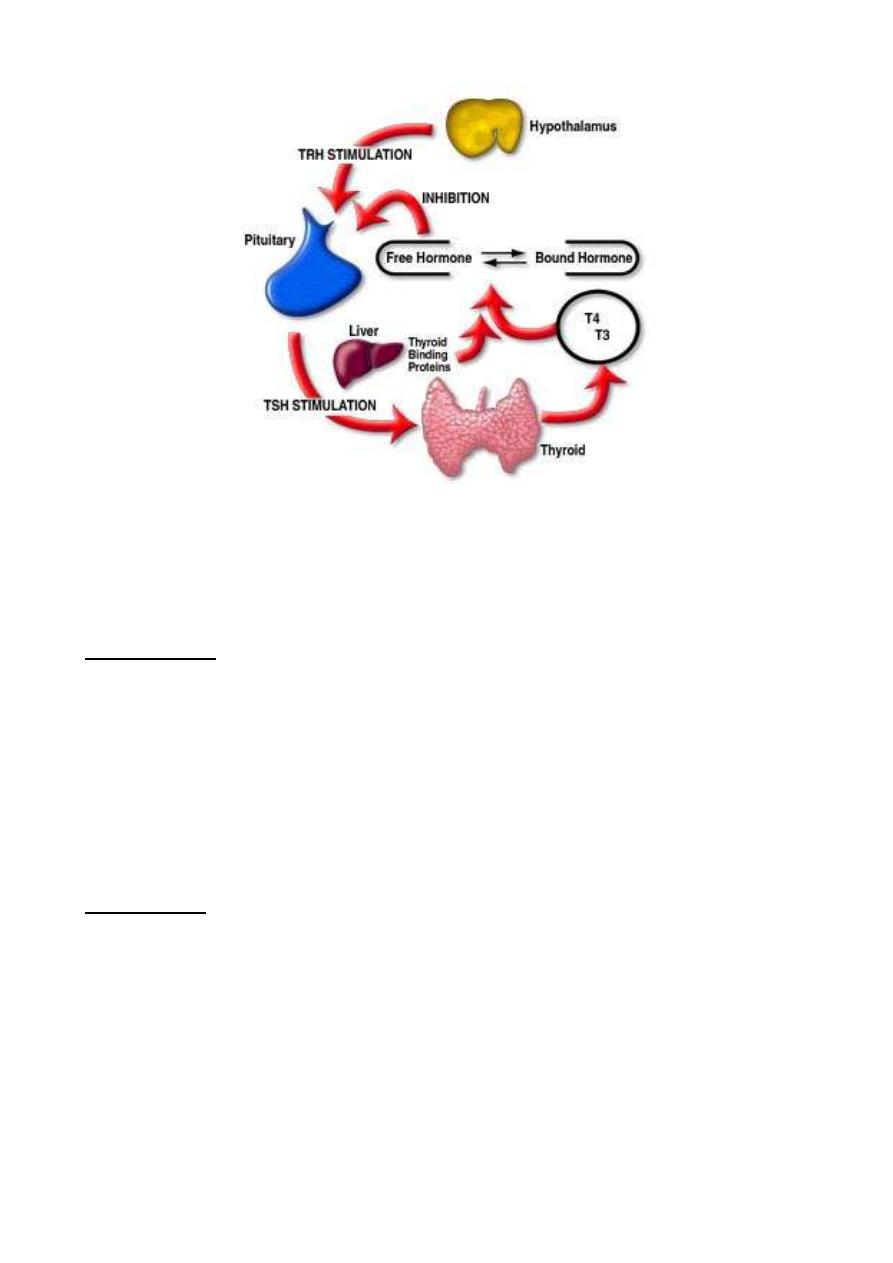
Prof. Dr. Hedef Dhafir El-Yassin
2013
11
Inhibition of TRH secretion leads to shut-off of TSH secretion, which leads to shut-off of
thyroid hormone secretion. As thyroid hormone levels decay below the threshold, negative
feedback is relieved, TRH secretion starts again, leading to TSH secretion...
Quick quiz 3:
The mechanism that helps regulate the endocrine system is
called the:
1. transport mechanism
2. self-regulation mechanism
3. feedback mechanism
4. pituitary-target gland
Conclusion:
1. Hormones can be classified according to their biochemical structure or
water solubility.
2. The receptor must be able to recognize a unique binding site within the
hormone and must be able to transmit the information gained from
binding to the hormone into a cellular response.
3.
Feedback circuits are at the root of most control mechanisms in the
endocrine syste
